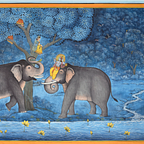Stories Behind Pichwai
Stories Behind Pichwai: Unveiling the Artistry and Spirituality of Traditional Indian Paintings
India, a land steeped in vibrant culture and rich heritage, has been a cradle for diverse forms of art. Among the many artistic treasures that adorn the tapestry of Indian culture, Pichwai paintings stand out as a testament to the intricate craftsmanship and deep spiritual symbolism. Originating from the sacred town of Nathdwara in Rajasthan, these paintings are not merely artistic expressions but encapsulate profound stories that delve into the realms of devotion, tradition, and the divine.
1. The Origin of Pichwai:
Pichwai, a Sanskrit word, can be broken down into ‘pich,’ meaning back, and ‘wai,’ meaning textile hanging. Essentially, Pichwai paintings are large cloth paintings that serve as backdrops for the idols of Lord Krishna in temples, particularly in the famous Krishna temple of Nathdwara. The art form can be traced back to the 17th century when the deity of Shrinathji, a manifestation of Lord Krishna, was installed in the temple.
2. Devotion in Brushstrokes:
At the heart of every Pichwai painting lies an unwavering devotion to Lord Krishna. Artists, often belonging to families that have been practicing this art for generations, infuse each brushstroke with love and reverence. The central theme revolves around depicting the various leelas (divine exploits) of Lord Krishna — from his playful interactions with the gopis (milkmaids) to the mesmerizing episodes of his childhood.
3. The Iconography of Pichwai:
Pichwai paintings are characterized by meticulous details and a vibrant color palette. The depictions are highly symbolic, with each element carrying layers of meaning. The divine figure of Shrinathji is usually depicted with a distinct almond-shaped eye and a peacock feather adorning his crown. The intricate jewelry, clothing, and background elements contribute to the overall opulence of the artwork.
4. The Seasons of Krishna:
One fascinating aspect of Pichwai paintings is the depiction of Lord Krishna in various seasons, known as ‘Baras.’ Each season is associated with specific colors, moods, and activities. For example, the monsoon season might portray Krishna playing the flute amidst lush greenery, while the winter season could feature him adorned in rich, warm hues, surrounded by devotees seeking solace in his divine presence.
5. The Artistic Process:
Creating a Pichwai painting is a labor-intensive process that demands both skill and patience. The canvas, typically a large piece of cloth, is first treated with a mixture of gum and limestone to create a smooth surface. The outline is then sketched using charcoal or pencil. Artists use natural pigments sourced from minerals, plants, and even precious stones to bring the paintings to life. Gold and silver leaf are often used to add a touch of celestial radiance.
6. Spiritual Significance:
Pichwai paintings aren’t merely decorative pieces; they hold profound spiritual significance. In the temple of Nathdwara, these paintings are changed daily to align with the ongoing season and festivities. Devotees believe that the act of changing the Pichwai is a form of seva (service) to the deity, and it is believed to bring blessings and prosperity.
7. The Nathdwara Tradition:
The town of Nathdwara, nestled in the Aravalli Hills, is the epicenter of Pichwai art. The tradition of creating these intricate paintings has been passed down through generations within specific communities. The artists, often known as ‘pichwaiwalas,’ take pride in their role as the custodians of this ancient art form. Many families have dedicated their lives to the service of the deity and the craft.
8. Commercialization and Challenges:
In recent times, Pichwai paintings have transcended the boundaries of temples and become sought-after art pieces globally. While this has brought recognition to the art form, it has also posed challenges. Commercialization sometimes dilutes the spiritual essence of Pichwai, with mass-produced imitations flooding the market. Striking a balance between preserving tradition and adapting to modern demands is a delicate challenge faced by contemporary Pichwai artists.
9. Pichwai in Contemporary Art:
Despite the challenges, Pichwai art has found a place in contemporary artistic expression. Many artists are experimenting with the traditional form, infusing it with modern themes and techniques. This not only keeps the art alive but also ensures its relevance in a changing world. The intricate details and spiritual depth of Pichwai paintings continue to captivate art enthusiasts and collectors alike.
10. Preserving the Legacy:
Preserving the legacy of Pichwai art is not just the responsibility of the artists but also of art connoisseurs, historians, and the broader community. Efforts to document the history, techniques, and stories behind Pichwai paintings are crucial in ensuring that this cultural gem thrives for generations to come. Workshops, exhibitions, and educational initiatives play a vital role in raising awareness and appreciation for Pichwai art.
Conclusion:
In the canvas of Indian art, Pichwai paintings stand as a testament to the timeless blend of spirituality and artistic expression. The stories behind Pichwai are not confined to the strokes of a brush; they extend to the devotion of generations, the vibrant traditions of Nathdwara, and the enduring legacy of Lord Krishna. As we admire the intricate details and vibrant colors of Pichwai paintings, we are not just witnessing art; we are partaking in a spiritual journey that transcends time and connects us to the divine.
Explore the rich heritage of Pichwai paintings with BeyondSquare’s online collection. Immerse yourself in the vibrant colors and intricate detailing of these traditional Rajasthani artworks. Each piece tells a unique story, blending spirituality and artistry. Purchase Pichwai artworks effortlessly through BeyondSquare’s user-friendly platform, bringing the essence of India’s cultural tapestry to your home.
